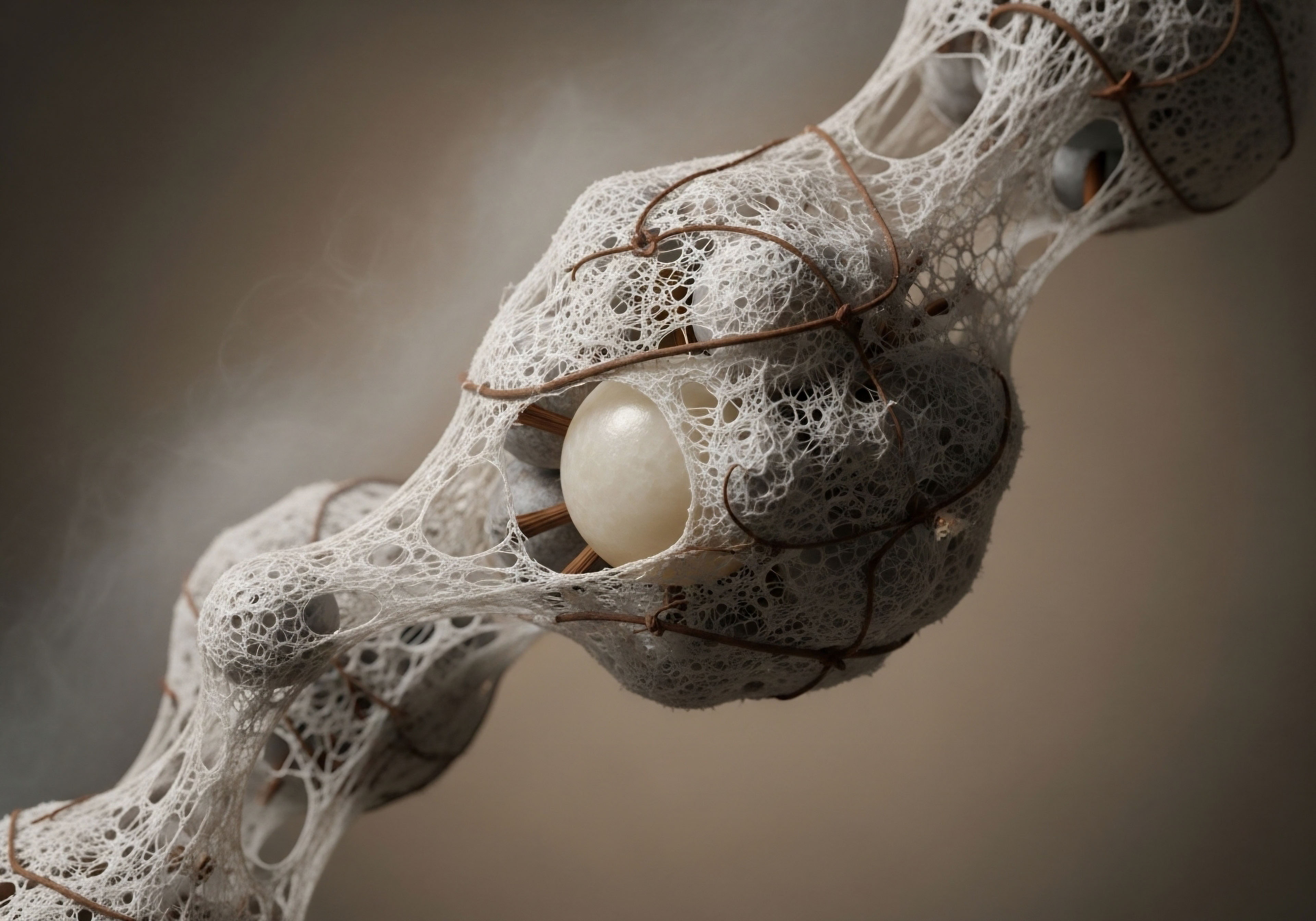

Fundamentals
Experiencing a persistent dip in vitality, a subtle yet undeniable shift in your physical and mental landscape, can leave you feeling disconnected from your true self. Perhaps your energy levels have waned, your sleep patterns feel disrupted, or your physical recovery seems to take an extended period.
These sensations are not merely isolated occurrences; they represent your body’s intricate messaging system signaling a potential imbalance within its complex biochemical networks. Understanding these signals marks the initial step toward reclaiming your inherent vigor and optimal function. This journey involves a deep appreciation for your internal biological systems, particularly the endocrine architecture, which orchestrates countless processes influencing your overall well-being.
The human body operates as a symphony of interconnected systems, with hormones serving as the primary conductors. These chemical messengers, produced by endocrine glands, travel through the bloodstream, influencing nearly every cell and tissue. When these hormonal communications falter, even slightly, the repercussions can extend across various physiological domains, affecting everything from metabolic efficiency to cognitive clarity.
Our exploration centers on two pivotal components of this endocrine network ∞ testosterone and growth hormone peptides. Examining their roles and potential interplay offers a pathway to understanding how to recalibrate your system for sustained health.

The Endocrine System an Overview
The endocrine system comprises a collection of glands that produce and secrete hormones directly into the circulatory system. These hormones then travel to distant target organs, regulating a vast array of bodily functions. Consider the hypothalamic-pituitary-gonadal (HPG) axis, a prime example of this intricate communication.
The hypothalamus, located in the brain, releases gonadotropin-releasing hormone (GnRH), which prompts the pituitary gland to secrete luteinizing hormone (LH) and follicle-stimulating hormone (FSH). These gonadotropins then act on the gonads ∞ testes in males and ovaries in females ∞ to stimulate the production of sex hormones, including testosterone and estrogen. This feedback loop ensures precise regulation, maintaining hormonal equilibrium.
Hormones act as the body’s internal messengers, orchestrating a wide array of physiological processes.
Another vital axis involves growth hormone. The hypothalamus releases growth hormone-releasing hormone (GHRH), which stimulates the pituitary gland to produce and release growth hormone (GH). GH then acts directly on tissues and also stimulates the liver to produce insulin-like growth factor 1 (IGF-1).
Both GH and IGF-1 play significant roles in cellular growth, metabolism, and tissue repair. When the production or signaling of these hormones becomes suboptimal, individuals may experience symptoms such as reduced muscle mass, increased adiposity, diminished energy, and impaired recovery.

Testosterone’s Central Role in Well-Being
Testosterone, often recognized as a primary male sex hormone, holds a significant physiological presence in both men and women. In males, it is predominantly produced in the testes and is responsible for the development of male reproductive tissues and secondary sexual characteristics.
Beyond these functions, testosterone influences muscle mass, bone density, red blood cell production, mood regulation, and cognitive function. A decline in testosterone levels, a common occurrence with advancing age or due to other factors, can manifest as a spectrum of symptoms. These include persistent fatigue, reduced libido, diminished muscle strength, increased body fat, and a general sense of reduced vitality.
For women, testosterone is produced in smaller quantities by the ovaries and adrenal glands. Despite its lower concentration, it plays a critical role in female sexual health, bone density, and overall energy levels. Symptoms of low testosterone in women can include decreased libido, persistent fatigue, and a reduced sense of well-being. Recognizing these symptoms is the first step toward exploring personalized solutions that address the underlying biochemical shifts.

Growth Hormone Peptides Unveiled
Growth hormone peptides represent a class of compounds designed to stimulate the body’s natural production of growth hormone. Unlike synthetic human growth hormone (HGH) injections, which introduce exogenous hormones, these peptides work by signaling the pituitary gland to release its own stored GH. This approach often results in a more physiological release pattern, potentially reducing the risk of side effects associated with supraphysiological HGH levels.
Key growth hormone peptides include Sermorelin, Ipamorelin, and CJC-1295. Sermorelin is a GHRH analog, mimicking the natural hormone that prompts GH release. Ipamorelin is a selective growth hormone secretagogue (GHRP) that binds to ghrelin receptors, inducing a pulsatile release of GH without significantly affecting cortisol or other hormones.
CJC-1295, available with or without a Drug Affinity Complex (DAC), is another GHRH analog. The DAC version provides a longer half-life, allowing for less frequent dosing, while the non-DAC form (often called Modified GRF 1-29) has a shorter duration of action, mimicking natural pulsatile release. These peptides are often sought for their potential to support muscle growth, reduce adiposity, enhance recovery, and improve sleep quality.


Intermediate
Once the foundational understanding of hormonal systems is established, the conversation naturally progresses to the specific clinical protocols designed to restore balance and optimize function. The integration of growth hormone peptides with testosterone optimization protocols requires a meticulous approach, considering the unique physiological landscape of each individual. This section details the ‘how’ and ‘why’ of these therapeutic interventions, providing insight into the agents, their mechanisms, and the strategic considerations for their combined application.

Testosterone Optimization Protocols a Closer Look
Testosterone replacement therapy (TRT) aims to restore circulating testosterone levels to a healthy range, alleviating symptoms associated with deficiency. For men, a standard protocol often involves weekly intramuscular injections of Testosterone Cypionate, typically at a concentration of 200mg/ml. This injectable form provides a steady release of testosterone due to its esterification, which slows its absorption and metabolism.
Alongside testosterone, other medications are frequently incorporated to manage potential side effects and preserve endogenous function. Gonadorelin, a bioidentical form of GnRH, is often prescribed via subcutaneous injections, typically twice weekly, to stimulate the testes to maintain natural testosterone production and fertility. This helps mitigate testicular atrophy, a common consequence of exogenous testosterone administration, which can suppress the HPG axis.
Another important component is Anastrozole, an aromatase inhibitor, administered orally, often twice weekly. Aromatase is an enzyme that converts testosterone into estrogen. By inhibiting this conversion, Anastrozole helps manage estrogen levels, preventing potential side effects such as gynecomastia or water retention that can arise from elevated estrogen. In some cases, Enclomiphene may be included to support LH and FSH levels, further aiding in the preservation of natural testicular function.
Testosterone replacement protocols are tailored to individual needs, balancing therapeutic benefits with careful management of the endocrine system.
For women, testosterone optimization protocols are distinctly different, reflecting their lower physiological requirements and sensitivity to the hormone. Women experiencing symptoms such as irregular cycles, mood changes, hot flashes, or reduced libido may benefit from very low-dose testosterone. Protocols often involve Testosterone Cypionate, typically 10 ∞ 20 units (0.1 ∞ 0.2ml) weekly via subcutaneous injection.
This precise dosing minimizes the risk of masculinizing side effects while still providing therapeutic benefits. Progesterone is also prescribed, particularly for peri-menopausal and post-menopausal women, to support hormonal balance and address symptoms like sleep disturbances or mood fluctuations. In certain situations, long-acting testosterone pellets may be considered, with Anastrozole used when appropriate to manage estrogen levels, similar to male protocols but with adjusted considerations for female physiology.

Growth Hormone Peptide Protocols
Growth hormone peptide therapy is designed for active adults and athletes seeking benefits such as anti-aging effects, muscle gain, adiposity reduction, and improved sleep quality. The choice of peptide and its administration schedule depends on the desired outcome and the peptide’s pharmacokinetic profile.
- Sermorelin ∞ As a GHRH analog, Sermorelin stimulates a natural, pulsatile release of GH. It is often administered daily, typically at bedtime, to mimic the body’s natural nocturnal GH surge. This approach aims to restore youthful GH secretion patterns.
- Ipamorelin / CJC-1295 ∞ This combination is popular due to its synergistic action. CJC-1295 (with DAC) provides a sustained GHRH signal, while Ipamorelin, a GHRP, delivers a strong, pulsatile GH release. Together, they can create a more robust and prolonged elevation of GH and IGF-1 levels. Dosing often involves subcutaneous injections, sometimes daily or multiple times per week, depending on the specific formulation and individual response.
- Tesamorelin ∞ This GHRH analog is particularly recognized for its role in reducing visceral adiposity, especially in specific clinical populations. Its mechanism involves stimulating endogenous GH release, which in turn influences lipid metabolism.
- Hexarelin ∞ A potent GHRP, Hexarelin stimulates GH release through ghrelin receptors. It is known for its rapid and significant GH release, though its use may be more limited due to potential effects on cortisol and prolactin at higher doses.
- MK-677 (Ibutamoren) ∞ This is an orally active growth hormone secretagogue, meaning it stimulates GH release when taken by mouth. It works by mimicking the action of ghrelin, leading to increased GH and IGF-1 levels. Its oral bioavailability makes it a convenient option for some individuals seeking the benefits of GH elevation.

Synergistic Integration of Protocols
The question of safely integrating growth hormone peptides with testosterone optimization protocols is a central consideration. Both classes of compounds influence anabolic pathways and metabolic function, suggesting a potential for synergistic benefits. When testosterone levels are optimized, the body’s capacity for protein synthesis, muscle repair, and overall metabolic efficiency is enhanced. Introducing growth hormone peptides can further amplify these processes by stimulating the release of endogenous GH and IGF-1, which are also critical for tissue regeneration and metabolic regulation.
A thoughtful integration strategy involves careful monitoring of biochemical markers, including total and free testosterone, estrogen (estradiol), IGF-1, and potentially other metabolic indicators. The goal is to achieve a balanced physiological state where both hormonal systems operate optimally without adverse interactions. For instance, improved sleep quality from GH peptides can support overall hormonal health, as sleep plays a critical role in the pulsatile release of many hormones, including testosterone.
Consider the potential for enhanced recovery from physical exertion. Testosterone supports muscle protein synthesis and repair, while GH and IGF-1 contribute to cellular regeneration and collagen production. Combining these elements can lead to more efficient recovery, reduced muscle soreness, and improved adaptation to training stimuli. This integrated approach acknowledges the body as a unified system, where improvements in one area can positively influence others.

Other Targeted Peptides and Their Applications
Beyond growth hormone secretagogues, other peptides offer specific therapeutic applications that can complement a comprehensive wellness protocol.
- PT-141 (Bremelanotide) ∞ This peptide is specifically designed to address sexual health concerns. It acts on the central nervous system, stimulating melanocortin receptors in the brain to increase sexual desire and arousal in both men and women. Unlike traditional erectile dysfunction medications that primarily affect blood flow, PT-141 targets the neurological pathways involved in libido, offering a distinct mechanism of action.
- Pentadeca Arginate (PDA) ∞ PDA is gaining recognition for its role in tissue repair, healing, and inflammation reduction. This synthetic peptide promotes collagen synthesis and angiogenesis (the formation of new blood vessels), which are vital for wound healing and tissue regeneration. It can be beneficial for individuals recovering from injuries, surgeries, or those seeking to reduce chronic inflammation and support overall tissue health.
These specialized peptides exemplify the precision offered by peptide therapy, allowing for highly targeted interventions that address specific physiological needs within a broader wellness framework.


Academic
The sophisticated interplay between hormonal axes and metabolic pathways represents a frontier in personalized wellness. Moving beyond the foundational and intermediate concepts, this section delves into the deep endocrinology and systems biology that underpin the safe and effective integration of growth hormone peptides with testosterone optimization protocols. Our focus here is on the intricate molecular mechanisms and the systemic consequences of these combined interventions, drawing from clinical research and physiological principles.

The Hypothalamic-Pituitary-Gonadal Axis and Growth Hormone Axis Intersect
The body’s endocrine system functions through a series of interconnected feedback loops, often described as axes. The hypothalamic-pituitary-gonadal (HPG) axis governs reproductive and sexual hormone production, while the hypothalamic-pituitary-somatotropic (HPS) axis regulates growth hormone secretion. While distinct, these axes do not operate in isolation; they influence each other through various molecular signaling pathways.
Testosterone, a steroid hormone, exerts its effects by binding to androgen receptors (ARs) located in target cells throughout the body. Upon binding, the testosterone-AR complex translocates to the nucleus, where it modulates gene expression, leading to anabolic effects such as increased protein synthesis and muscle hypertrophy. The presence of optimal testosterone levels can enhance the responsiveness of tissues to other anabolic signals, including those mediated by growth hormone and IGF-1.
Growth hormone peptides, such as Sermorelin and CJC-1295, function as GHRH analogs, binding to the growth hormone-releasing hormone receptor (GHRHR) on somatotroph cells in the anterior pituitary gland. This binding activates intracellular signaling cascades, primarily involving the adenylyl cyclase/cAMP/PKA pathway, leading to the synthesis and pulsatile release of GH.
Ipamorelin, a GHRP, acts on the ghrelin receptor (GHS-R), also located in the pituitary and hypothalamus, inducing GH release through a distinct but complementary mechanism, often involving phospholipase C and calcium mobilization. The selective nature of Ipamorelin, which minimizes cortisol and prolactin release, makes it a preferred GHRP in many protocols.
The body’s hormonal axes are not isolated, but rather interconnected, influencing each other through complex signaling pathways.
The integration point lies in the systemic effects. Elevated GH and IGF-1 levels, stimulated by peptides, can enhance the anabolic environment created by testosterone optimization. IGF-1, in particular, shares structural homology with insulin and mediates many of GH’s anabolic and growth-promoting effects.
It acts via the IGF-1 receptor (IGF-1R), a tyrosine kinase receptor, initiating downstream signaling pathways such as the PI3K/Akt/mTOR pathway, which is critical for cell growth, proliferation, and survival. This pathway is also influenced by testosterone, suggesting a convergence of anabolic signaling.

Metabolic Interplay and Clinical Considerations
The metabolic implications of combining these protocols warrant detailed examination. Testosterone plays a significant role in glucose metabolism and insulin sensitivity. Hypogonadal men often exhibit insulin resistance and an unfavorable lipid profile. Testosterone replacement can improve insulin sensitivity, reduce visceral adiposity, and positively influence lipid parameters.
Growth hormone, through its effects on IGF-1, also influences glucose and lipid metabolism. While supraphysiological levels of exogenous HGH can sometimes induce insulin resistance, the pulsatile, endogenous release stimulated by GH peptides is generally considered to have a more favorable metabolic profile. The goal is to optimize the body’s natural GH production, which can contribute to improved body composition (reduced fat mass, increased lean muscle mass) and enhanced metabolic flexibility.
Consider the impact on body composition. Testosterone directly promotes muscle protein synthesis and reduces fat accumulation. GH and IGF-1 contribute to lipolysis (fat breakdown) and further support muscle anabolism. The combined effect can lead to a more pronounced improvement in lean body mass and a reduction in adiposity, particularly visceral fat, which is metabolically active and associated with increased cardiometabolic risk.
A key clinical consideration involves monitoring the estradiol (E2) levels in men undergoing TRT. Testosterone can aromatize into estrogen, and elevated E2 levels can lead to adverse effects. Anastrozole, by inhibiting aromatase, helps maintain E2 within a physiological range. The interaction with GH peptides is generally indirect; however, maintaining hormonal balance across all axes is paramount for safety and efficacy.

Can Growth Hormone Peptides Affect Fertility in Men on TRT?
A significant concern for men on TRT, particularly younger individuals, is the potential impact on fertility. Exogenous testosterone suppresses the HPG axis, leading to a reduction in endogenous testosterone production and, critically, impaired spermatogenesis. Gonadorelin is often prescribed to mitigate this suppression by stimulating LH and FSH release from the pituitary, thereby supporting testicular function and sperm production.
The question arises ∞ do growth hormone peptides influence this delicate balance? Growth hormone and IGF-1 have roles in reproductive physiology, including spermatogenesis and steroidogenesis. However, the primary mechanism of GH peptides is to stimulate GH release, not directly to stimulate gonadotropin release from the pituitary in the same manner as GnRH analogs or selective estrogen receptor modulators (SERMs) like Clomid or Enclomiphene.
While some research suggests Sermorelin may have some influence on FSH and LH, its primary action is on the HPS axis.
Therefore, while GH peptides can enhance overall metabolic health and anabolism, they are not a direct substitute for agents like Gonadorelin, HCG, or SERMs when the specific goal is to preserve or restore fertility in men on TRT. A comprehensive protocol for fertility preservation would still prioritize direct HPG axis support.
The safety profile of integrating these therapies relies on a thorough understanding of their individual pharmacodynamics and potential interactions. Regular laboratory monitoring, including complete blood count (CBC), lipid panel, liver function tests, and specific hormone levels (total and free testosterone, estradiol, IGF-1), is essential to ensure therapeutic efficacy and to identify any potential adverse effects early.
This data-driven approach allows for precise adjustments to dosing and protocol components, ensuring the individual’s journey toward optimal health is both effective and well-managed.
| Peptide | Mechanism of Action | Primary Receptor Target | Duration of Effect |
|---|---|---|---|
| Sermorelin | Mimics natural GHRH, stimulating pulsatile GH release | GHRHR (Pituitary) | Short (minutes to hours) |
| CJC-1295 (with DAC) | Modified GHRH analog, binds to albumin for extended action | GHRHR (Pituitary) | Long (up to 1 week) |
| Ipamorelin | Selective GHRP, induces pulsatile GH release without significant cortisol/prolactin | Ghrelin Receptor (GHS-R) | Short (approx. 2 hours) |
| Tesamorelin | GHRH analog, reduces visceral adiposity | GHRHR (Pituitary) | Moderate |
| Component | Purpose | Typical Administration (Men) | Typical Administration (Women) |
|---|---|---|---|
| Testosterone Cypionate | Testosterone replacement | 200mg/ml weekly IM | 10-20 units (0.1-0.2ml) weekly SubQ |
| Gonadorelin | Preserve testicular function/fertility | 2x/week SubQ | Not typically used |
| Anastrozole | Manage estrogen conversion | 2x/week oral tablet | As appropriate (e.g. with pellets) |
| Progesterone | Hormonal balance (women) | Not typically used | Based on menopausal status |

References
- Teichman, S. L. et al. Prolonged stimulation of growth hormone (GH) and insulin-like growth factor I secretion by CJC-1295, a long-acting analog of GH-releasing hormone, in healthy adults. The Journal of Clinical Endocrinology and Metabolism, 2005, 91(3), 799-805.
- Sermorelin vs. CJC-1295 vs. Ipamorelin ∞ Comparing Popular Growth Hormone Peptides. Innerbody Research, 2025.
- What is the starting dose of Testosterone (Test) Cypionate for women? Dr.Oracle AI, 2025.
- Testosterone Cypionate ∞ Side Effects, Dosage, Uses, and More. Healthline, 2024.
- Coadministration of anastrozole sustains therapeutic testosterone levels in hypogonadal men undergoing testosterone pellet insertion. PubMed, 2013.
- The Power of Peptides ∞ Tools to Optimize Body Composition. Yoo Direct Health, 2025.
- Peptide Therapy ∞ Enhance Performance, Healing, and Longevity. Holistic Medical Wellness, 2025.
- PT-141 FOR MEN ∞ A NEW DRUG TO TREAT ERECTILE DYSFUNCTION AND LOW LIBIDO. Invigor Medical, 2025.
- 10 Powerful Benefits Of Pentadeca Arginate (PDA) For Athletes And Fitness Enthusiasts. Amazing Meds, 2025.
- PDA ∞ The Peptide Revolutionizing Regenerative Medicine. PUR-FORM Health, 2024.

Reflection
The journey toward understanding your own biological systems is a deeply personal and empowering endeavor. This exploration of growth hormone peptides and testosterone optimization protocols offers a glimpse into the sophisticated mechanisms that govern your vitality and function. It is a testament to the body’s remarkable capacity for recalibration when provided with precise, evidence-based support.
Consider this knowledge not as a destination, but as a compass guiding your path. Each individual’s biochemical blueprint is unique, and true wellness arises from a personalized approach that respects this inherent variability. The insights gained here serve as a foundation, prompting further introspection about your own health narrative and the specific avenues that may lead to your optimal state of being.

What Are the Long-Term Implications of Combined Hormonal Therapies?
The sustained benefits of these integrated protocols extend beyond immediate symptom relief, aiming for enduring physiological resilience. As you consider your next steps, remember that a collaborative relationship with a knowledgeable healthcare provider is paramount. They can translate complex laboratory data into meaningful insights, tailoring protocols to your specific needs and monitoring your progress with precision. Your commitment to understanding your body’s signals, coupled with expert guidance, forms the cornerstone of a proactive approach to health.



